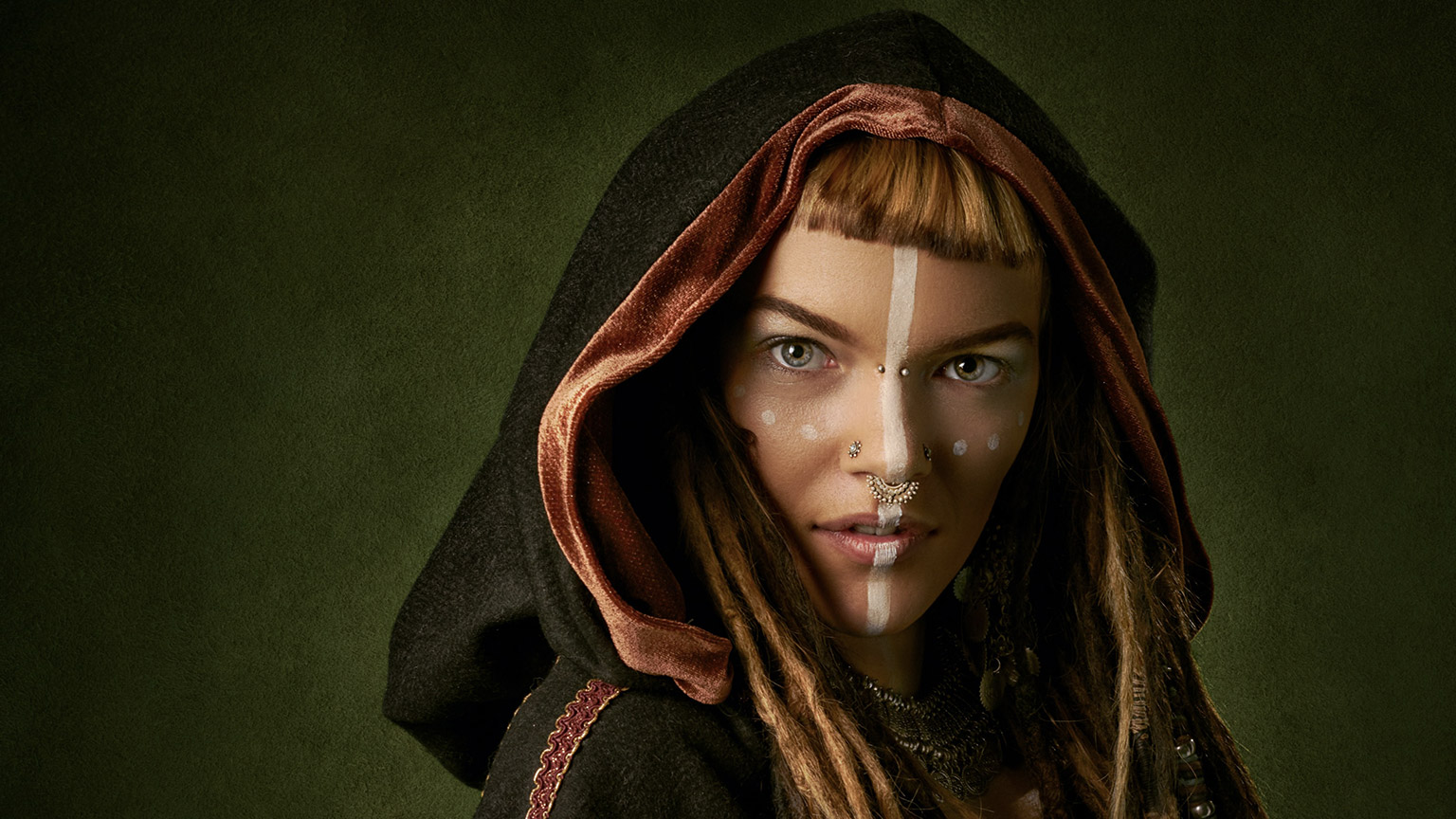Richard LinklaterThere are a million ideas in a world of stories. Humans are storytelling animals. Everything’s a story, everyone’s got stories, we’re perceiving stories, we’re interested in stories. So to me, the big nut to crack is to how to tell a story, what’s the right way to tell a particular story.
When creating films, writers focus on storytelling. They create a narrative with a sequence of events either in verbal, written or picture form that is put together in a way that creates a storyline for their audience.
There are many ways a story can be told. Writers can tell a story in a linear fashion: first, this happened, then that did, and so on; or it can be backwards, where the action starts where the story ends, and the time spent with the plot explains what happened in reverse order - or it may jump back to the beginning and work their way back to the final point in the story. A great example of using a timeline in a non-linear fashion to tell a story is the 2000 film Memento, an American neo-noir mystery.
The sequence of time in a story isn't the only tool in filmmaking to tell a story. Audio and shot choices give the audience clues as to where we are in the story. Is this part scary or sad? Should the audience be worried the main character is about to get a nasty surprise? Sound effects, background music, scene composition, and shot choices all help the audience follow the action and become engaged and engrossed in the plotline without even realising the filmmaker used these techniques to manipulate their feelings!
What makes a story engaging?
To create a good story, you will need to consider the basic elements that are essential to a film narrative, including the plot and storyline.
Let's look at those terms. According to Masterclass:
| Plot | The plot of a book, film, or play is the series of events that unfold from start to finish. The plot explains not just what happens but also the causality — how one event leads to another. |
| Storyline | A story is a complete narrative. It contains the plot, as well as other literary devices such as character development, settings, and themes. |
A storyline is a series of events that occur through time, supporting the audience in learning more about the characters, the setting and the moral of the storyline — engaging the audience and creating an emotional connection to the film.
Time in and of itself is a powerful storytelling tool. Short timeframes can be intriguing. For example, Spike Lee's 1989 Do The Right Thing took place over a single very hot day in New York, while an epic tale, like Martin Scorsese's 2002 Gangs of New York, takes place over 155 years. In both cases, the time factor, without going into science fiction, has a significant impact on the audience's experience of the story.
Story structure
Story structure is the order or arrangement of events that happen in a story. This includes the beginning, middle and end, regardless of the direction of time in the story.
Why structure is used
Following a story structure (specific order of events) allows us to craft better stories. In turn, this evokes more of an emotional response from the audience and, therefore, a better payoff.
| Beginning | 20% of the story. | Introduce characters and their everyday world/setting. Inciting incident: a problem, goal, conflict, obstacle, object of desire or motivation is established. |
|---|---|---|
| Middle | 70% of the story. |
Characters go through a series of struggles, setbacks and complications (called 'reversals') as part of the process to achieve the goal, defeat the monster, get the girl, overcome conflict/obstacles and so on. This is where the rising action, climax and falling action of the story occur. |
| End | 10% of the story. |
Characters return to their world having solved the problem, reached their goal, and overcome obstacles. |
Story sequence and story structure are linked but distinct.
Story structure refers to the overarching framework or blueprint of a film's narrative. It outlines the major plot points and their arrangement in a logical order. The most common example is the three-act structure (beginning, middle, end).
Story structure provides the overall organisation of the narrative. This diagram shows that the structure is made up of several components of the story.
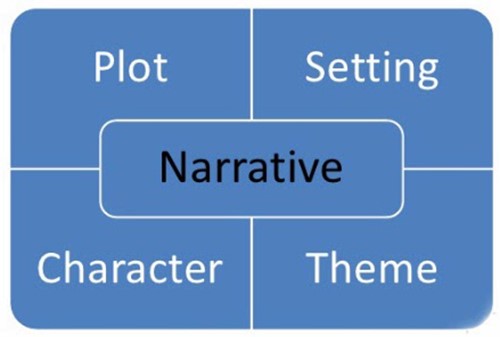
Story sequences are the individual scenes or segments within a film that contribute to the larger story structure. They are the building blocks of the narrative and are arranged sequentially (not necessarily linearly) to convey the plot, character development, and themes effectively. Sequences often have a distinct beginning, middle, and end within the larger structure. Story sequence refers to the order the sequences are placed to create the storyline.
Story structure is the big-picture framework of a film's narrative, while story sequences are the smaller, sequential elements that make up that structure.
Here is a sample story sequence:
- Establishing character in their everyday world
- But they want something…
- They enter an unfamiliar situation…
- They adapt to a new situation
- They get what they wanted
- They, however, pay a heavy price for it
- They return to their familiar situation
- They have developed and grown as a character.
For example, a heist film might include an extended recruitment sequence in which the leader of the gang collects the conspirators, followed by a robbery sequence and finally ending with an escape sequence. Watch the 2001 remake of Ocean's 11 for a perfect example of this sequencing.

Here is a sample story narrative:
Jo and Steven have always wanted a baby together, but they are not able to conceive one. They both live and work in Auckland in middle management jobs that they are not excited about, just going through the motions. They give up invitations to spend time with others, they don't 'believe' in travel and rarely do anything outside of their routine. Having mysteriously found a winning ticket for a trip for two to Stewart Island, they reluctantly go. While there, they are drawn into a cave, only to come out of it with a 6-month-old baby in Jo's s surprisingly swollen belly. Three months later, they have a child, but it's a hell child, and they discover it is literally a demon spawn. They travel to the Bay of Islands to get the demon soul replaced with Henere, a young boy who had died in a car accident and was being given a new life. Realising life needs to be lived to the fullest in each moment, they relish their new family and take on new adventures with joy. They also find themselves close family friends with Henere's family with no knowledge of the connection.
Here is a sample story structure with that narrative at the centre:
Act 1: Setup
- Jo and Steven live in Auckland and lead mundane lives, avoiding travel and excitement.
- They receive a winning ticket for a trip to Stewart Island [the inciting incident that disrupts their routine].
- During their trip, a mysterious event occurs where Jo becomes pregnant.
Act 2: Confrontation
- The birth of their child reveals that it has demonic qualities [creating a central conflict].
- Jo and Steven decide to travel to the Bay of Islands to perform a ritual to swap their child's demon soul with Henere's innocent soul. [This journey represents the rising action and their quest to resolve the conflict.]
Act 3: Resolution
- The ritual succeeds, and their child is transformed into an innocent being.
- Jo, Steven, and their now "normal" child return home, transformed by their experiences.
- They embrace life fully, going on adventures together, which signifies their character growth.
- They unknowingly become close family friends with Henere's family, creating a sense of closure and interconnectedness.
A good story structure will look something like this:
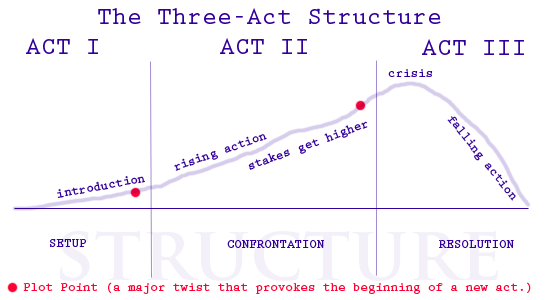
You are likely familiar with the story of the Three Little Pigs. The following image provides a plot diagram for the story:

After watching the video below, can you identify the beginning, middle and end of the story? Complete the multiple-choice questions that follow to confirm your understanding.
Can you see the three stages of this story? Describe them below. You will find out immediately if the answer is correct and the questions will progress automatically.
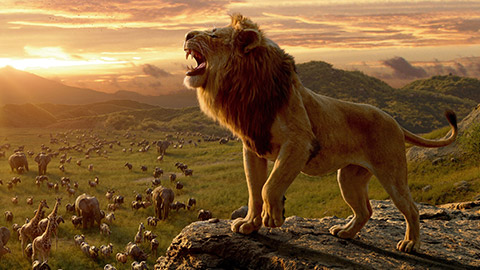
As mentioned at the top of this section, audio is a useful tool the storyteller can use to engage the audience in the plotline when it is used strategically.
The sound must match their expectations to make the audience believe the action is real. This image of a lion practically begs for sound. And you can likely anticipate what that sound will be. Imagine if the sound was more of a meow than a roar. It could be funny or just wrong - that's up to the filmmaker to choose. You can play into expectations or against them as a stylistic choice.
Another example is a person knocking on a door — we expect to hear the sound of knuckles on a wooden surface. If the sound is muffled or isn't genuine, it takes the audience away from the story.
Filmmakers often turn to pre-recorded (sometimes called 'canned') sounds to accomplish this. Watch Everything you hear on film is a lie by Tasos Frantzolas, to learn more about it.
Now, have a bit of fun and see if you can identify sounds without visual cues. Click the 'play' arrow to listen to the sound, and then select the option that most likely describes it.
For another insight into the impact of sound, watch this short, funny interview on Instagram, where Liam Neeson talks about the first time he wielded his lightsaber on set!
Remember, lightsabers aren't real, and yet both actors immediately filled in the expected sound.
Why is the sound department important?
George LucasMovies are 50 percent of what you see and 50 percent of what you hear.
Every movie has four sonic elements:
Dialogue
- Direct sound
- Voice of characters
- ADR (Additional Dialogue Recording)
- Usually, on the first layer of audio in the timeline
Atmosphere
- Close your eyes. Hold your breath. What do you hear?
- Ambience and/or atmosphere
- Movies sound dead without it
- Usually, on the second layer of audio in the timeline
Sound FX
- Sound effects
- What you see is not exactly what you get
- Usually, in the third and fourth layers of the timeline
Music
- Musical track, not ‘soundtrack’
- Usually, the last sound layer in the timeline
Diegetic or non-diegetic
Sounds can be either diegetic or non-diegetic. The sounds that occur within the storyline or action in the video or film’s world are termed diegetic sounds. The sound can come either from on-screen or off-screen, but it always happens at the same time that the action takes place. Non-diegetic sounds are also called "complementary" and happen post-production primarily. Films often move between them. An example of this technique is when a character is listening to headphones, but the audience is privy to the music they hear, which is diegetic sound because the sound represents the action on screen. That music can then become non-diegetic when the scene changes (to a montage, for example), but the music persists through the following scene(s). Learn more about this at Adobe.
The impact of background audio
Watch the following four videos to see how the same footage can have wildly different effects on the audience based on the audio used (along with a slight increase in playback speed to enhance the effect).
The Black Satans version 1
The Black Satans version 2: Benny Hill Music
Cybergoth version 1
Cybergoth version 2: Thomas the Tank Engine music
Important
In order to become a filmmaker in this course, you'll need to learn how to use Adobe's Premiere Pro. Head over to the Design Principles and Tools > Premiere Pro Tutorials section and do all of the activities so you can return to the content in this course and have fun with film! May the force be with you.

Newbie Activity - Matching voice and visuals
🕔 About 2 hours
Let's jump right in:
- Download the activity files in the folder, SW script, noting where you are placing these files.
- Take note of all of the subfolders and their contents: the Wars of Stars.prproj project file, a PDF script file, and the asset folders.
- Watch Dan's instructional video. He'll walk you through what you'll need to get started.
- Create voice recordings of the dialogue in the Star wars script section.pdf document. We encourage you to find partners to collaborate with. You might use the Messages feature here to reach out to your peers, or you can ask friends or family to help. Otherwise, dust off your acting skills and take on all the characters yourself.
- Bring in your newly recorded audio clip(s) into Premiere Pro.
- In the Premiere "assembly" workspace, make sub-clips from your main recordings of the best takes from the recording session.
- You may like to head back to review the YouTube videos in Design Principles and Tools > Premiere Pro Tutorials > Sub-clips.
- Once the sub-clips are made, change to the editing workspace to edit the dialogue over the images.
- Use the images from the folder as a visual backdrop to support the script.
- When your project is complete, Export your work as a .mp4
- Go to the Export tab:

- Name the file, choose the correct folder to save it in, and click the Export button.
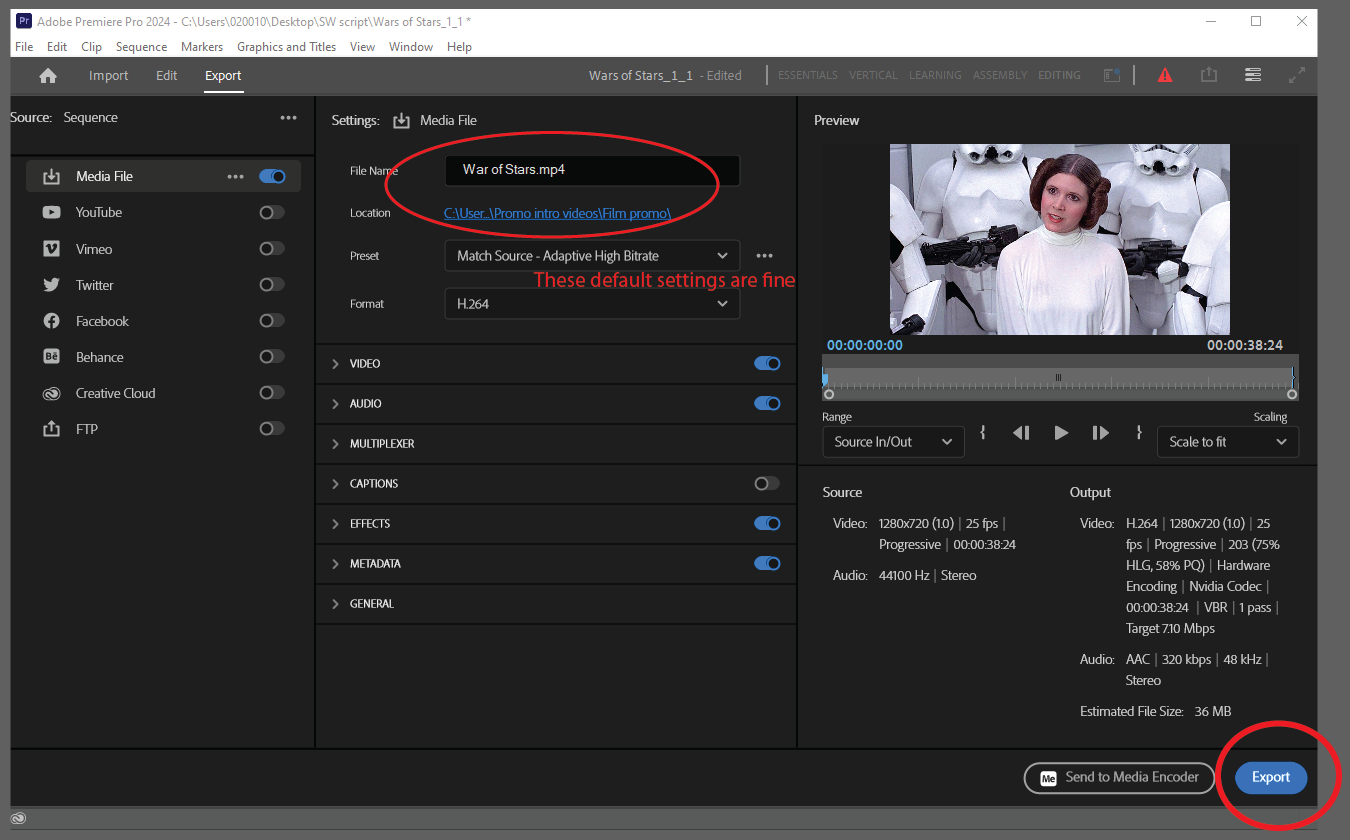
- Go to the Export tab:
Forum Post
Now it's time to share your work in the Forum for this activity.
Please include the following reflective thoughts in your post:
- Provide a critical review of your own work for this assignment.
- What are some things you did really well on this assignment?
- If you could do this assignment over, what would you do differently?
- If you chose to work with others, did you find the collaborative part of this challenging?
- What did you learn by doing this project?
After posting, view the work of your peers and provide helpful feedback on at least two projects.
If you like, expand the label below to listen to an audio recording of the project and the finished activity by past students.
Listen to a voice recording session only:
Final version from a past student. (Audio + Video)

Making a character interesting to an audience
This is harder than it sounds, but some important points to think about are:
- Giving your character some type of goal. Then make the character as ambitious as you possibly can to achieve that goal — a half-hearted character who never gains motivation to achieve their goal, or worse, they easily achieve the goal, is almost always going to make a dull story.
- Make sure every action your character makes has a reason. If the character’s motivation is unjustified or unnecessary, then your audience could feel disconnected from the film. It’s quite easy to make a character unlikeable through a lack of effort, causing them to lack competency (e.g. your audience will dislike a character who forgets to bring a sword to fight the dragon if defeating the dragon is what the character really cares about. It would be better if the sword broke just before the battle due to unforeseen circumstances).
- Raise the stakes. Frodo taking the Ring to Mordor is more exciting than if Aragorn were to do it. This is because, in a fight against an army of Orcs, Frodo doesn’t stand a chance. It’s easier for Frodo to fail and, therefore, more rewarding when he succeeds. Always try to make your antagonist better than your protagonist — this will force the protagonist to work harder to overcome them.
Character Roles
Let's expand our learning about creating interesting characters by looking at what audiences have already come to expect from archetypes. As an audience member yourself, at times, you will have become familiar with these character types, but you may not have even realised it. Have a bit of fun with this activity about character types.
That was just seven character types, but there are so many more. Even more than the 99 in this article, 99 Archetypes and Stock Characters (PDF) which we encourage you to download and use as a resource.
Practising Activity - The character's voice
🕔 Spend up to two hours to write the story and about an hour for production
This activity is similar to the Star Wars activity, but you use different assets and create your own script.
For inspiration, you'll pick 5-10 images randomly. You will then weave them together into a story. From that story, you will need to pick two characters and flesh them out. Once you have them in mind, you'll create something for them to say.
Getting started:
- Create a new project folder in the Root folder. Use this folder structure:

- Visit this random image generator and download 5-10 images, storing them in the folder 04 Images. Try to honour the challenge of the activity by making this random, and don't discard images that you perceive as too hard.
- Once you have your images, create a story that is inspired by sequencing these images.
- Create a character study to develop two characters from the story. For this activity, you will be exploring the voice of the character, so don't spend much time sketching or thinking about their looks. We won't be able to see the scars.
- Let's revisit InDesign for this activity. While it can easily be accomplished in a simple word editor, keeping your skills fresh at hand is important. If you leave it too long without working on a piece of software, it will be harder to jump back in. Since we provide templates for you to use to manage your assessments in InDesign for this certificate, you'll want to keep your skills in that software warm.
- Download, extract (unzip), and open the InDesign Character Study Template. Look at page one. You may need to scroll up to see it at first.
- Go back to the Creating Characters topic from Animation and review what it takes to create a character if you want.
- Once your characters are imagined on page 1 of the character study template, write a script on page 2 — an introduction for each of them to say to each other.
- Start out by writing a monologue for each character so you can ground the character and get a feel for their (create some) style and mannerisms.
- Record your scripts and store them in the folder 01 Dialogue.
- Open Premiere Pro and set up a new project, bringing in your assets (images and dialogue).
- Match your script to the images to build the story.
- Export your work into your project folder.
- If you want, go back to task 6 and write, then record a conversation between the characters. Update your project to include the new dialogue.
Forum Post
Upload your project in this Forum with answers to the following questions:
- Did you feel the work you did on the Star Wars project helped you to feel more confident to do this one? If not, why not?
- What are you proud of when you watch your movie?
- What would you do differently?
- What did you learn by doing this project?
- Any other reflections you would like to share?
Optional Showing off Activity - Create the scene
🕔 Spend as much or as little time with this as you like.
You can take this activity to the next level! Karawhiua! Give it all you've got!
- Create a new Root folder and subfolders for a new project like the one above, and bring in the assets you need from the previous ones.
- Add background sounds, sound effects, and music to augment your scripted speech and the images, putting them into the appropriate folders.
- Feel free to grab more images to fill in the gaps in your story.
- You will be able to use this work as part of your summative assessment, so save it!
Forum Post
Share it! Hit Reply on your previous Forum post and add in this new version along with your comments about what you changed and why. Don't forget to check out the work of your peers and provide them with helpful feedback.
Have fun!
Character arcs are a great way of exploring a theme. Without character arcs and themes, films can feel like they wander their way through the story and can lack a feeling of beginning, middle and end.
When writing a film, there is only one rule: DON’T BE BORING. If you decide not to have any themes or character arcs, then be careful not to bore your audience.
Typically, there are three character arcs — positive, negative and flat.
| Positive | This is where the character learns something during the film which makes the character a better person. Usually, they begin the film by lying to themselves about something to make themselves happy. This lie will then find a way to flip their world upside down and they must conquer their flaws in order to live a happier life. For example, Shrek thinks he lives happily without any friends. He is then forced to work with Donkey and other people and learns the importance of friendship along the way. In the middle of the film, Shrek has the option to go back to his old life but makes a conscious decision to go out and save Fiona. | 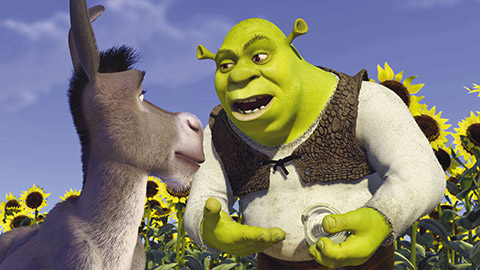 |
| Negative | This is where the character is repeatedly faced with conflict because of their flaws but fails to learn and refuses to fix their flaws. This leads the character down a dark path, and their situation worsens (e.g. Darth Vader, Walter White, Jordan Belfort in The Wolf of Wall Street). | 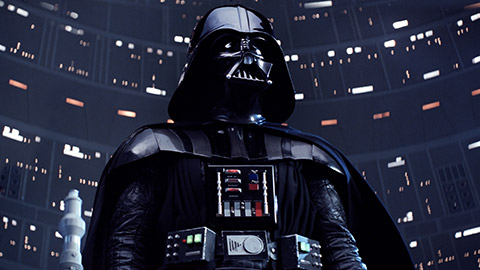 |
| Flat | This is where the character believes something that is true but is surrounded by people who are blind to this truth. This character will start and end the film with the same personality and beliefs (although will often have many doubts along the way) but usually influences many of the supporting characters around them. Usually, mentor characters will have flat arcs (e.g. Gandalf, Obi-wan, Yoda, Dumbledore, Morpheus), although main characters can also have flat arcs (e.g. The Hunger Games, Gladiator). | 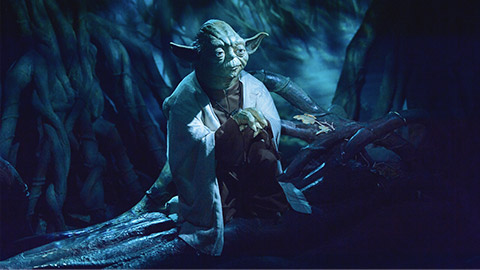 |
